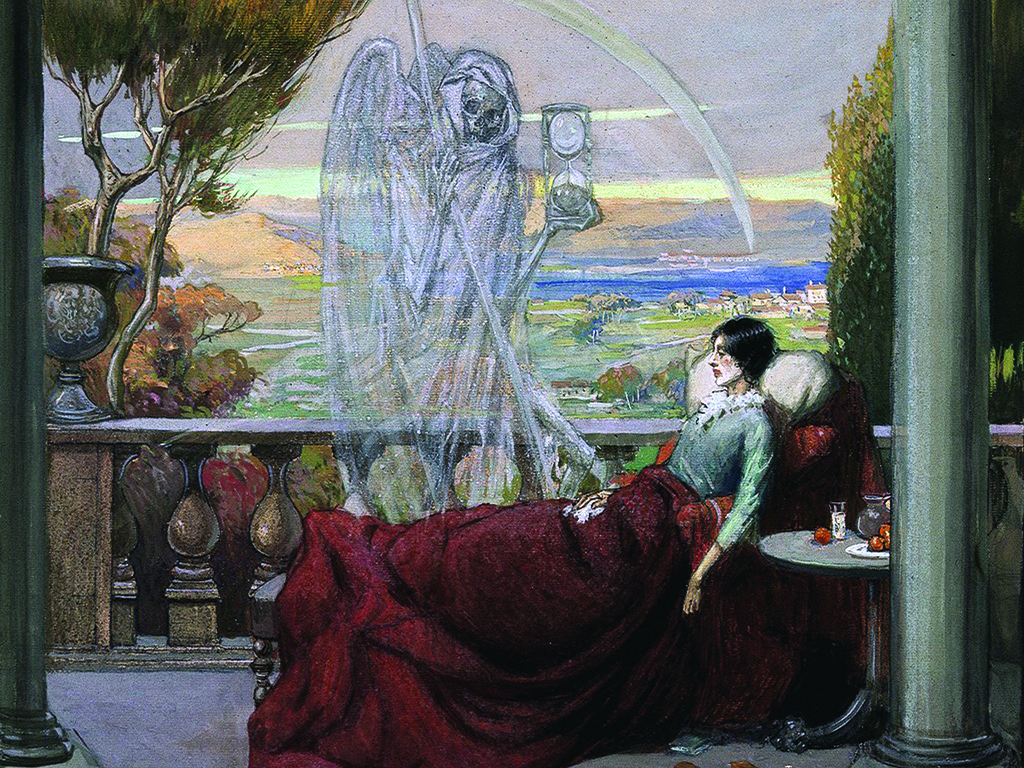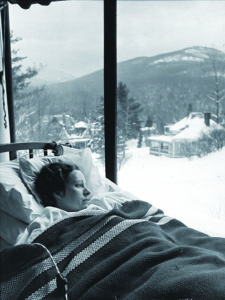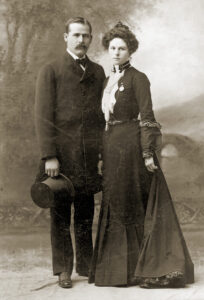Before antibiotics, tuberculosis was a leading cause of death, a national fixation, and the scourge of artists
Henry Baldwin spent the month of May 1849 keeping vigil at his young wife’s bedside in Newport, New Hampshire. “Here I sit in the dear chamber—the ‘bridal chamber’—where one short year ago I first pressed to my heart a young and pure and blooming wife,” the engraver and illustrator wrote in his diary. “Then how fair and hopeful and beautiful she seemed, with the bloom upon her cheek . . . Now, alas, she lies all pale, stricken, and dying.” Marcia Baldwin, 21, had consumption, an inscrutable wasting disease that terrified and obsessed Americans.
Antibiotics’ arrival in the mid-20th century defanged consumption, as tuberculosis was once known, but earlier the disease—responsible for as many as a third of deaths in America—brought terror. The ailment was especially feared in New England, where settlement and living patterns—the close quarters of farmhouses and small, tightly knit villages—encouraged its spread. When Rhode Islander Samuel Tillinghast tracked mortality among acquaintances in the 1750s and 1760s, he found that over half had fallen to consumption. Transforming life, altering ambitions, and reshaping the very culture, consumption morbidly fascinated Americans.
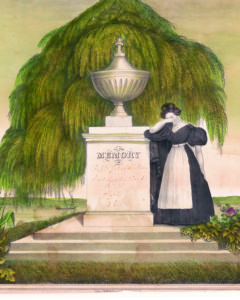
Marcia Baldwin’s husband recorded the young woman’s eight-month ordeal. “I have watched her gradual decay,” he wrote. “I have seen the full, round, and rosy cheeks fade away, the elastic steps grow weak and altogether fail, the ringing, pleasant tones of her gentle voice subside to the feeble & broken whisper.” In March 1849, Marcia, undone by “a distressing attack of bleeding at the lungs,” took to her bed—for good. Henry bathed her through enervating fevers, held her as convulsions and crippling pain wracked her emaciated frame, and tried to position her so she could breathe. “What a dreadful scourge is consumption. It seizes upon the loveliest of earth’s flowers and blights and withers them away,” he wrote in early June. “It loves the ruddy cheek, and vampire-like delights to feed upon the ruby lips. Ghostliness and pallor alone remain to mark its desolation wheresover it passes.” An entry made weeks later reads, “The scene is closed. My beloved Marcia has gone and left me here alone!” But not for long; in 1855 Henry, 39, followed Marcia to the grave.
Marcia and Henry Baldwin both died of pulmonary tuberculosis [See “Talking TB, below], aka “the White Plague.” No one knew its cause or its cure, but everyone knew its symptoms. First, a cough, persisting, perhaps unremarked upon, for weeks or months. Next, an intermittent—or “hectic”—fever that weakened its host. Patients lost vigor, grew pale and paler, bodies ever more fragile. The White Plague seemed to digest flesh, as if consuming the life force. Breathing became labored, and pain tortured the chest and sides. As lesions in the lungs putrefied that tissue, coughing brought up blood. Morning chills alternated with evening fevers that soaked the body in sweat. At the end, many patients seemed mere skeletons sheathed in papery skin, beset by coughing spasms, unable to draw breath, drowning in bloody phlegm—a horrifying, mesmerizing display of mortality.
The ancient Greeks called tuberculosis Φθίσις or phthisis, meaning “wasting.” In early America, doctors trained in the tradition of the ancient Roman physician Galen employed that term, but lay folk said “consumption.” Tuberculosis has long been present in North America; traces appear in the bones of pre-contact indigenes. English settlers recognized the disease John Bunyan termed “the captain of all those men of death.” Smallpox, plague, and cholera were known to be contagious, but English and American doctors did not believe consumption communicable.
In truth, no one knew how the disease spread—but everyone knew a consumptive or feared becoming one. Apprehension begat obsession. By the early 1800s, consumption—with its inscrutable and unpredictable course—was haunting American life. Some patients died quickly, of “galloping consumption.” Others suffered a prolonged “lingering death.” A few survived in relatively good albeit delicate health, or even saw their symptoms resolve. Uncertain prognosis fostered both terrible fear that each cough was a death sentence, and fervent hope that it was not.
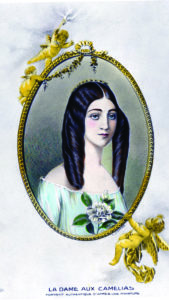
Cruelly, most consumptives were in the bloom of youth. The disease could claim a generation of a family, taking child upon child until the nest was empty. In her diary, Caroline Seabury dolefully recorded the deaths in the 1850s of seven of her eight siblings on Cape Cod from the disease. In 1816, between losing two sisters, Phebe Melven, 14, of Concord, Massachusetts, stitched a family history on a sampler.
Her closing verse reads Unhappy he who latest feels the blow/Whose eyes have wept o’er every friend laid low/Drae’d lingering on from partial death to death/’Till dying all he can resign is breath. The Concord Yeoman’s Gazette noted in 1826, “Though father and mother live to advanced age, their children and grand-children fall before them by a disease which no human skill has yet been found able to cure.”
Puritan New Englanders stoically accepted youngsters’ deaths as a heart-wrenching manifestation of God’s will.
Of his dead offspring, poet Edward Taylor wrote, “I say, take, Lord, they’re thine./I piecemeale pass to Glory bright in them./I joy, may I sweet Flowers for Glory breed,/Whether though getst them green, or lets them seed.” When all but three of preacher Cotton Mather’s 15 children died young, Mather kept his grief to his diary; neighbors praised his family for being “in full possession of themselves, in patience and benevolence,” resigned to God’s will.
But attitudes began to shift. By the 1790s, Americans were beginning to embrace the Enlightenment values placed on reason, science, and technology. Confidence emerged in individuals’ capacity to shape their destiny. Old tropes of fate and faith faded; unpredictable and uncontrollable death now unnerved people. Doctors decried “the alarming increase in Consumption in the United States,” and warned that the rising generation’s “doomed hopes” threatened the nation’s future. Though consumption incidence had not risen, concern about consumption had, generating an intense focus on its imagined causes and inescapable effects.
Unaware of germs, patients and doctors suspected heredity, environment, and behavior to be at play. Consumptive elites were thought to pass along a predisposition to the malady; a sensitive temperament and a delicate frame, it was said, foretold wasting death. So, it was theorized, did genius, for what burned brightest burned fastest—artistic brilliance literally consuming possessors. The middle classes risked consumption in their behavior, said doctors, urging young men not to exhaust their souls with excessive study or desk work and cautioning young women against immodest fashions, rib-crushing corsets, and the excessive pleasures of dancing and reading novels. Consumption among the poor was often attributed to immorality: promiscuity, insobriety, filthy habits. Environment in the form of chill night drafts and miasmas—noxious vapors gusting from swamps and boarding houses alike—could fell anyone anytime.
Once consumption “settled” in a patient, the focus shifted from prevention to remedy. Consumptives consulted lay healers, or physicians, or both, and both sectors competed with a gabble of self-described experts, patent medicine floggers, and purveyors of commercial treatments, all promising cures and all driven by the profit motive.
Care took place mainly in the home, and was provided mainly by women. Caregivers relied on accumulated generations of lore. They brewed broths, distilled elixirs, molded lozenges, boiled steamy fumigants, and mixed plasters to relieve coughing, fever, and pain. Alcohol was a mainstay. Many domestic remedies relied on the magical belief that “like treats like.” Blood being thought the font of vigor and spirit, remedies often ran red or invoked it—broth from the meat of a red rooster, milk from a red cow. A vogue developed for concoctions made from the spotted oval leaves of lungwort, a plant believed to resemble a set of diseased lungs.
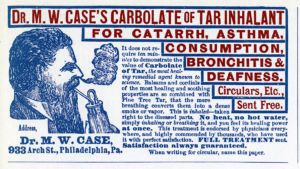
In rural Hallowell, Maine, domestic healer and midwife Martha Ballard made for consumptive niece Parthenia Pitts “a Syrup of Comfrey, Plantain, Agrimony & Soloman’s Seal leaves.” Parthenia continued to decline. She followed her aunt’s counsel and “rose about an hour by Sun in ye morn, went out & milkt ye last milk from ye Cow into her mouth & Swallowd it.” Some patients slept in barns crowded with livestock so as to inhale cows’ reputedly healthful exhalations; others inhaled fumes from white pitch and beeswax heated over flames. Concoctions made from snails and their slime were popular for soothing coughs and easing breathing.
The better off patient might consult a physician trained in bodily humors, an ancient Greek theory that in its effort to balance the four humors—blood, black bile, yellow bile, and phlegm—embraced “heroic” therapeutics: bleeding and deliberately induced vomiting, diarrhea, and sweating. One treatment—based on Enlightenment faith in chemical cures—dosed patients with mercury. Among medical practitioners, realists admitted privately that the only treatment for consumption was “opium and lies.”
The market flung up an extraordinary range of regimens and products. Homeopaths believed in plants’ medicinal and spiritual powers, and some packaged botanical kits and published books. William Buchan’s Domestic Medicine and John C. Gunn’s Domestic Medicine, or Poor Man’s Friend described treatments in lay language and often represented isolated rural or frontier settlers’ only medical resource. Entrepreneurs hawked disease-specific chairs, stoves, and often elaborate breathing apparatuses such as that “great preventative of consumption, and unfailing cure for pulmonary disease…the medicated fur chest protector.”
Sales of “patent” medicines exploded. A February 1825 advertisement for Dr. Relfe’s Asmatic Pills informed Columbian Centinel readers that “a lady of Hampden, Me., …seriously afflicted with consumption…and expected to die within a few hours,” instead had been restored to health by a single box of that nostrum. Preparations and pamphlets invoked links to Indian methods. The Indian Vegetable Family Instructer promised that its “selected Indian prescriptions” would cure consumption “after every other remedy had failed.” In the 1840s, Brother Corbett’s Wild Cherry Pectoral Syrup began a long reign as a preferred treatment.
Purified botanicals marketed by the Shakers, a Protestant sect, were thought efficacious against consumption (“Complicated Gifts,” February 2019). Some customers trusted Shakers even more deeply.
The Bradleys of Concord, New Hampshire, a self-described “sick family” with both generations consumptive, sent youngest daughter Cynthia to live at nearby Canterbury Shaker Village in hopes of saving her. Her brother, Cyrus, visited Cynthia in 1833. He was impressed by the Shaker doctor and his botanical garden. Cynthia, it seems, was impressed with the Shakers. Cyrus noted: “She has gained much in her health, but nothing can induce her to leave the people who have treated her so well.” Cynthia never returned to her family, but she survived them all.
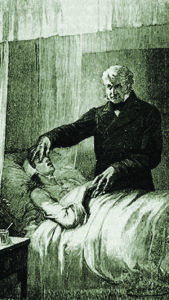
Another treatment was to hit the road. Theorizing that fresh air worked wonders, doctors advised patients to journey on horseback or by sea. Fearing the supposedly baneful effects of damp northern air, consumptives able to afford southern sojourns sought balmier locales. In 1784, minister Elisha Parmele, 29, asked his Lee, Massachusetts, congregation’s leave to travel again to Virginia; two earlier stays had rejuvenated the ailing preacher but only temporarily. Congregants assented. Parmele trundled south with his wife in a wagon trailed by their cow. He died en route. Touring the Caribbean to document life among formerly enslaved people, consumptive abolitionists simultaneously escaped the northern winter. The White Plague became conjoined with the struggle against bondage. Southerners insisted the flood of consumptives to their region proved its way of life healthier, but visiting patients, seeing slavery first-hand, often returned foes of the peculiar institution.
The travel cure spurred demand for accommodations, encouraging construction of health resorts and spas. Turnpikes, canals, and railroads brought patients to facilities at the seashore, in the mountains, and near mineral springs. One man, revisiting a New Hampshire village once known only for commercial fishing, noted that consumptives had replaced cod as a business proposition. The seaside hamlet now counted three hotels—“large, furnished, and supplied with convenience for the accommodation of the sick,” plus private bathing and showering facilities and other “inducements to the invalid.” Mountain resorts sprang up from the Adirondacks to the Appalachians. Spas featuring cold or hot mineral waters, such as White Sulphur Springs in what was then western Virginia, became particularly popular. Spa proprietors often enclosed springs in elaborate pavilions, staging concerts and social programs designed to lure the business of upper class invalids.
Some healers created and thrived on cults of personality. In a volume touting his methods, New York City-based Dr. Samuel Fitch claimed to have achieved “a complete cure” for patients through a regimen of “medical inhalation,” medicines, and “instruments.” Rivals derided Fitch’s book as a “quack advertisement” and a “great farce and a complete humbug,” but patient Harriet Tappan of Panton, Vermont, was among many who came to his clinic. Following three months under Fitch’s care, Tappan lived long enough to marry but within a year of treatment had died.
Jacksonville, Florida, emerged as a winter haven for phthisis patients. Among treatments available there an observer listed, “the milk cure, the beef-blood cure, the grape cure, the raw-beef cure, the whisky cure, the health-lift cure, the cure by change of climate, and many more…”
Consumption’s highly variable course and the survival of but a fraction of patients lent many specious treatments a whiff of validity. Hoping for a miracle, patients mixed medicines and treatments. Julia Pierce of Winsor, Massachusetts, wrote to her sisters in the early 1840s of their younger brother’s efforts to regain his health. Addison Pierce tried roots, horseback riding, cold water showers, homeopathy, an Indian doctor’s advice, “taking the waters,” sea voyages, and care from a doctor promising a cure or no charge, his sister said. “If it appeared to have any efficacy, they were willing to give it a try,” historian Sheila Rothman wrote.
Desperation powered participants in a bizarre treatment pursued by some families who had lost multiple children. In 1788 Congregational minister Justus Forward of Belchertown, Massachusetts, having buried three children, had two more grow dangerously ill.
Neighbors claimed vampirism lay at the root of consumption. They recommended “therapeutic exhumation.” Among the recently deceased, these savants proposed, someone was “undead” and rising supernaturally at night to siphon away living siblings’ blood. To neutralize this killer, the Forwards had to disinter their dead children, identify the vampire, and burn its heart or scatter its bones. At first horrified, the Forwards in time consented. In his research into the ghoulish phenomenon, folklorist Michael Bell has documented instances of 80-plus therapeutic exhumations undertaken to cure consumption in New England between independence and the Civil War. The practice survived until the late 1800s, its persistence testament to the desperation of families stalked by consumption.
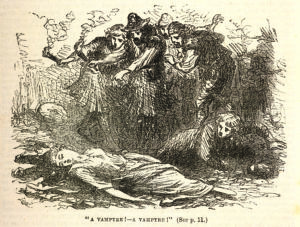
With its cause a mystery, its cure unknown, and its prognosis unpredictable, consumption permeated everyday life in the America of the 19th century. Youths suspected of predisposition to the ailment were advised to quit school, change jobs, and postpone wedlock or hurry into marriage. Families relocated to supposedly healthier climes. Grown offspring were pressed to return to the homestead to nurse kin or keep a farm running. Bereaved parents lived with punishing loss; dying parents gave their children away to family or friends. At society’s margins, consumptives faced death on the street or in the almshouse, as did their families.
Consumption troubled many leading cultural lights: authors Washington Irving, Nathaniel Hawthorne; and Edgar Allen Poe; philosopher-writers Ralph Waldo Emerson and Henry David Thoreau; poet William Cullen Bryant, artist Thomas Cole, and musician Stephen Foster. Death and invalidism drove a melancholy undercurrent in art and literature. Images of mourning maidens bent over funeral urns framed by weeping willow branches were emblematic of the era. Printers did brisk business selling mass-produced “memorial prints,” lithographs of generic onlookers mourning at graveside, the stone marker’s front left blank for personalization.
“Consolation literature” emerged—prose and verse saturated in sentiment and crooning of early partings and doomed affection—romantic, filial, or platonic—as in the 1832 Philadelphia Scrap Book & Gallery of Comicalities poem, “To a Friend Lingering With the Consumption”: Consumption’s lean and greedy worm/Is feasting on thy frame;/And soon, oh! Soon thy worried term/Shall end, and quench life’s flame.
The 1836 Mourner’s Book compiled verses along the lines of “Then wasting pain and slow disease traced furrow on the brow, The grasshopper, alighting, is felt a burthen now. . .” Teacher and poet Lydia Sigourney, a master of this genre whose own consumptive son had died at 19, frequently was hired to memorialize a schoolmate or child.
Morbid poetasting became a thing. Schoolchildren exchanged “friendship albums” into which they copied morose verse on themes like forget-me-nots, broken bonds, and imminent partings. Sabbath School Society booklets told of faithful children patiently enduring as death neared, such as 9-year-old Ann Elizabeth Pierce of Massachusetts telling her parents in 1833, I have sometimes wished I was well, but I do not now; I had rather die and be with my savior.
The deaths of consumptive innocents became plot points in potboilers. Little Eva in Uncle Tom’s Cabin by Harriet Beecher Stowe is perhaps the best known sick little saint, but consumptive lit had a seamier side. The widely circulated magazine Godey’s Lady’s Book featured stories populated by characters undone by vanity, pride, ambition, or lust. Consumptive heroines and their seductions made the pop-gothic novel a mainstay.
From Clarissa and Charlotte Temple to Les Miserables’ Fantine, the Lady of the Camellias, and La Boheme, fallen women rode unbridled passions to consumptive ends, tragically beautiful to the last.
Graveyard humor arose. The Monthly Traveler, in December 1830, noted that “a gentleman met another in the street, who was ill of a consumption, and accosted him thus: ‘Ah, my friend, you walk slow.’ ‘Yes,’ replied the man, but I am going fast.’” New York periodical Minerva offered verses “On a Gentleman Who Married a Consumptive Lady” in August 1823: With a warm skeleton so near,/And wedded to thy arms for life/When death arrives, it will appear/Less dreadful—’tis so like thy wife.
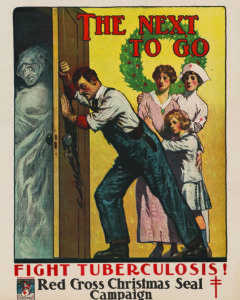
Beauty standards made room for gloom. Unlike smallpox or plague, consumption did not disfigure. Rather, its visible effects—slender, delicate body, pale skin setting off feverish red lips and cheeks, sunken eyes, overly dark and large, whispered breath—made the consumptive seem more beautiful and romantic, not less. Dressmakers emphasized these aspects in women, along with the small waist, flat chest, protruding spine, and sloped shoulders associated with the disease, to create tragic beauty. Robust fashionettes used cosmetics to mimic the consumptive’s pallid, feverish face. Belladonna eyedrops caused pupils to dilate with febrile intensity. The poet Lord Byron said he wished to die of consumption, “because the ladies would say: ‘Look at that poor Byron, how interesting he looks in dying.’” Byron was among those Romantics holding that consumption brought on a good death, killing slowly, sweetly, beautifully; malaria likely killed him.Consumption’s prominence as a protomeme faded as the 19th century progressed. One factor was the Civil War’s industrial-strength killing. Photographs of rotting corpses on battlefields like Gettysburg and Antietam took the fun out of morbidity and mortality. In 1882, German scientist Robert Koch identified Mycobacterium tuberculosis as the bacterium that causes tuberculosis, a discovery that earned Koch the 1905 Nobel Prize.
The revelation that a germ caused consumption not only grounded doctors and patients in medical reality but launched the age of the sanitarium at the turn of the century. (see “Mountain Medicine,” below). After World War II, antibiotics caused tuberculosis to fall out of the popular imagination in the United States, although HIV-AIDS, by compromising immune systems, engendered a resurgence. Worldwide, however, the disease remains one of the top ten causes of death, yearly killing 1.5 million. For many, consumption is yet “the captain of all those men of death.”
_____
Mountain Medicine
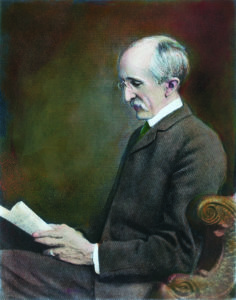 In 1885, Dr. Edward Livingston Trudeau, left, following a German plan, opened the first American sanitarium at Saranac Lake in upstate New York’s Adirondack Mountains. Trudeau, himself in remission from TB after adhering to a course of rest and a healthy diet in mountain air, wanted to replicate that treatment. As a test, he offered poor New Yorkers lodging, board, and a regimen he oversaw. Within 15 years, Trudeau’s rural rest cure experiment had grown from a few cottages to a sprawling institution. For patients able to afford them, such open-air retreats grew fashionable. The movement spread rapidly as municipalities and states tried to stop consumption from infecting middle and upper-class residents by isolating poor TB patients. Tuberculosis came to be seen as a disease of the immigrant, the poor, and the dissolute. In 1900 there were 34 sanitaria; by 1925 there were over 500, with more than half a million beds. Many patients found themselves “committed” to isolated facilities imposing strict bed rest for weeks, even months, sometimes on open-air porches, followed by sitting outdoors in “invalid” chairs offering the optimum angle for breathing. Waking and retiring, diet, even conversation were often strictly supervised. Many patients reported frustration, boredom, hostility, powerlessness, and shame at being sequestered. Arrival of streptomycin undid the sanitarium movement, whose legacy persists in sleeping porches, Adirondack chairs, mountain resorts, Thomas Mann’s Magic Mountain, and the recorded memories of former inmates of the “rest cure.” —Mary Fuhrer
In 1885, Dr. Edward Livingston Trudeau, left, following a German plan, opened the first American sanitarium at Saranac Lake in upstate New York’s Adirondack Mountains. Trudeau, himself in remission from TB after adhering to a course of rest and a healthy diet in mountain air, wanted to replicate that treatment. As a test, he offered poor New Yorkers lodging, board, and a regimen he oversaw. Within 15 years, Trudeau’s rural rest cure experiment had grown from a few cottages to a sprawling institution. For patients able to afford them, such open-air retreats grew fashionable. The movement spread rapidly as municipalities and states tried to stop consumption from infecting middle and upper-class residents by isolating poor TB patients. Tuberculosis came to be seen as a disease of the immigrant, the poor, and the dissolute. In 1900 there were 34 sanitaria; by 1925 there were over 500, with more than half a million beds. Many patients found themselves “committed” to isolated facilities imposing strict bed rest for weeks, even months, sometimes on open-air porches, followed by sitting outdoors in “invalid” chairs offering the optimum angle for breathing. Waking and retiring, diet, even conversation were often strictly supervised. Many patients reported frustration, boredom, hostility, powerlessness, and shame at being sequestered. Arrival of streptomycin undid the sanitarium movement, whose legacy persists in sleeping porches, Adirondack chairs, mountain resorts, Thomas Mann’s Magic Mountain, and the recorded memories of former inmates of the “rest cure.” —Mary Fuhrer
_____
Talking TB
Tuberculosis is caused by Mycobacterium tuberculosis, a bacterium spread by contact with infected sputum. Inhaled bacilli invade soft tissue and multiply, forming nodular lesions that break down and kill tissue. These “tubercules” can affect many organs, but most commonly attack the lungs. Onset can be quick, but the disease can remain latent for years, emerging under stress. Some patients defeat the disease unassisted, but without antibiotics people with active pulmonary tuberculosis usually experience a chronic, progressive decline marked by cough, fever, chest pain, extreme weight loss, and malaise. As tubercules destroy lung tissue, hemoptysis—coughing or “spitting blood”—results. Weakened bodies eventually succumb to respiratory failure—in effect, suffocation. A characteristic profound curvature of the upper spine occurs when tuberculosis of the lungs spreads to the spine. This causes a deformity in the upper spine that makes the shoulder blades prominent and the shoulders appear curved or sloped toward the front. Formally called Pott’s Disease, this “hump” was understood to be a feature of consumption. Until antibiotics arrived, TB dominated the popular imagination; fear of contagion was called “phthisophobia.” When in 1926 Winnie the Pooh author A.A. Milne gave Christopher Robin “the wheezles and sneezles,” the poem’s doctors warned “if he freezles in draughts and in breezles, the phtheezles might even ensue.” TB remains the most common form of infectious disease-related death in the world. —Mary Fuhrer

